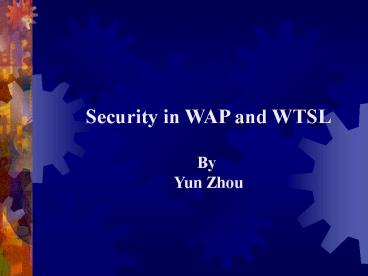Security in WAP and WTSL - PowerPoint PPT Presentation
Title:
Security in WAP and WTSL
Description:
Proposed by the WAP Forum (Phone.com, Ericsson, Nokia, Motorola) in 1997. ... WAP device (cell phone), WAP client/browser, User agent, ... – PowerPoint PPT presentation
Number of Views:111
Avg rating:3.0/5.0
Title: Security in WAP and WTSL
1
Security in WAP and WTSL By Yun Zhou
2
Overview of WAP (Wireless Application Protocol)
- Proposed by the WAP Forum (Phone.com, Ericsson,
Nokia, Motorola) in 1997. - A wireless communication model, similar to the
ISO OSI model - An application environment for deploying wireless
services regardless of different types of
services, wireless bearers, and devices. - WAP provides a series of security measures
- However, there are still various security
loopholes in WAP.
3
WAP Architecture
Components WAP device (cell phone), WAP
client/browser, User agent, Network operator
(companies that provides bearer services),
Bearer services (SMS, CDMA), Application server
4
WAP Protocols
- Recall the ISO OSI model
- WAE (Wireless Application Environment) WML,
WMLScript - WSP (Wireless Session Protocol) and WTP
(Wireless - Transaction Protocol) together provide session
layer services - connection oriented sessions or connectionless
sessions. Reliable - sessions can be resumed.
- WTLS (Wireless Transport Layer Security)
(Optional)
5
Overview of WTLS
- Based on TLS
- Provides client-server mutual authentication,
- privacy, data integrity, non-repudiation
- But not the same as TLS
- Modifications due to
- Narrow-bandwidth communication channel
- Much less processing power
- Much less memory
- High loss ratio
- Unexpected disconnections
- Restrictions on exported encryption algorithms
- Built on top of WDP and UDP (unreliable data
transfer) - More security problems
6
WTLS Sub-Protocols
- WTLS contains four sub-protocols
- Handshake protocol
- Client and server negotiate over the security
- parameters to be used for later message
exchanges - Alert protocol
- Specifies the types of alerts and how to
handle them. - warning, critical, fatal
- Alerts can be sent by either the client or the
server. - Application protocol interface for the upper
layer - Change Cipher Spec Protocol
- Usually used towards the end of the handshake
when the - negotiation succeeds
7
What does the handshake specify?
8
Handshake Procedure
Resume connection
Complete handshake
9
How Security Functions Are Achieved
- Authentication
- Supports X.509v3 and X9.68 certificates,
optimized sizes. - Key exchange RSA, DH, ECC-DH (Preferable
algorithm for WAP) - Bulk encryption algorithms
- RC5 with 40, 56 or 128 bit keys, DES with 40
or 56 bit keys, 3DES, IDEA with 40, 56 or 128 bit
keys, and ECC. (No stream ciphers) - master_secret PRF(pre_master_secret, "master
secret", ClientHello.random ServerHello.random)
- key_block PRF(master_secret expansion_label
seq_num server_random client_random) - Keys and IVs are all generated from key_blocks.
- Keys are refreshed according to the negotiated
frequency. - MAC algorithms SHA-1, MD5, and SHA_XOR_40
10
Security Loopholes, Threats, Solutions - WAP
Gateway
- Decrypts and re-encrypts data White spot
- End-to-end security, but the ends are actually
- the web client and the gateway.
- Solution by the network operators
- Decrypts and re-encrypts only in the memory
- Cannot solve the problem entirely
- still uses swapfiles, hackers can do core
dumps - Some companies try to completely get rid of the
- WAP gateway.
11
Deploy the Gateway in the Servers network
Decryption and re-encryption are done on the
server side.
12
Security Loopholes, Threats, Solutions - WTLS
- Has to use keys of small sizes
- 40-bit DES -gt 35 bits are actually used
- Allows weak algorithms to be chosen
- exchanges unauthorized messages or unencrypted
packet fields, such as alert messages and
recode_type field. - Vulnerable to viruses, Trojan horses, and worms.
- Saarinen discussed a chosen plaintext data
recovery attack, a datagram truncation attack, a
message forgery attack, and a key-search shortcut
for some exportable keys
13
Attack against SHA_XOR_40
- SHA_XOR_40
- Padded messages are divided into 5-byte
blocks. All blocks are XORed to get the digest. - Attack
- Flip a bit in one block, flip the bit in the
- corresponding position in the digest
- Tada! Message modification succeeds!
14
User Authentication vs. Device Authentication -
WIM
- Mobile devices are easy to lose
- One British article reported that for the first
time of this century the umbrella has been
overtaken as the most popular item to leave on a
train by mobile phones. - Cannot authenticate user if the passwords and
- certificates are stored locally
- Use WIM (Wireless Identity Module), which can be
a smart card or a SIM card. - Dedicated memory
- Provides user authentication
- Need to keep it separately from the device. Hard
to - achieve.
15
References
- Arehart, C., Professional WAP, Wrox Press Ltd,
2000. - Jormalainen, S., Laine, J. Security in WTLS,
10/1/2000. Referred on 3/24/2004,
lthttp//www.hut.fi/jtlaine2/wtls/gt - Nicolas, R., Lekkas, P. Wireless security
models, threats, and solutions. McGraw-Hill.
2002. - Saarinen, Markku-Juhani, Attacks against the WAP
WTLS Protocol, 9/221999 Referred on 3/24/2004,
lt http//www.jyu.fi/mjos/wtls.pdfgt - Schneier, B., Applied Cryptography, Second
Edition, John Wiley Sons, Inc, p. 758, 1996. - WAP Forum, WAP Security Group (WSG) Charter,
6/12/2002 Referred on 3/24/2004.

